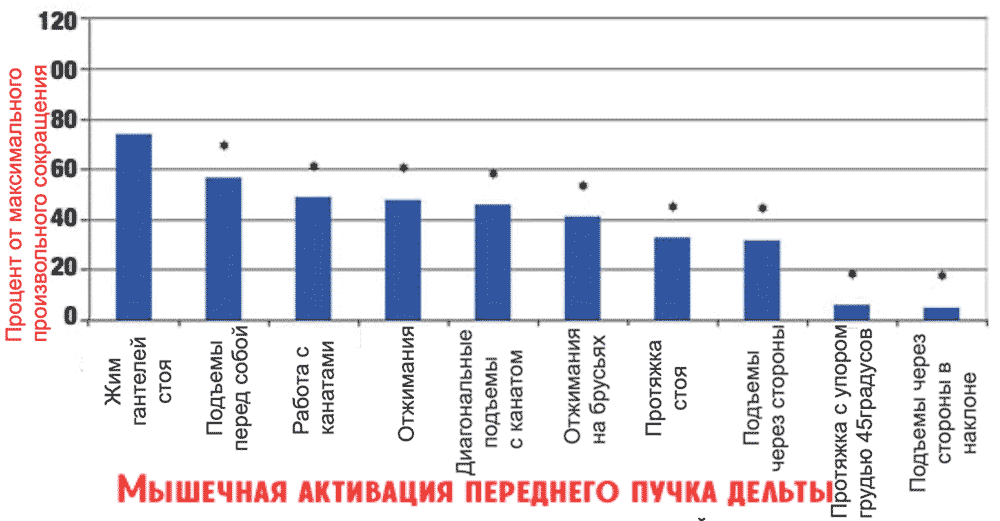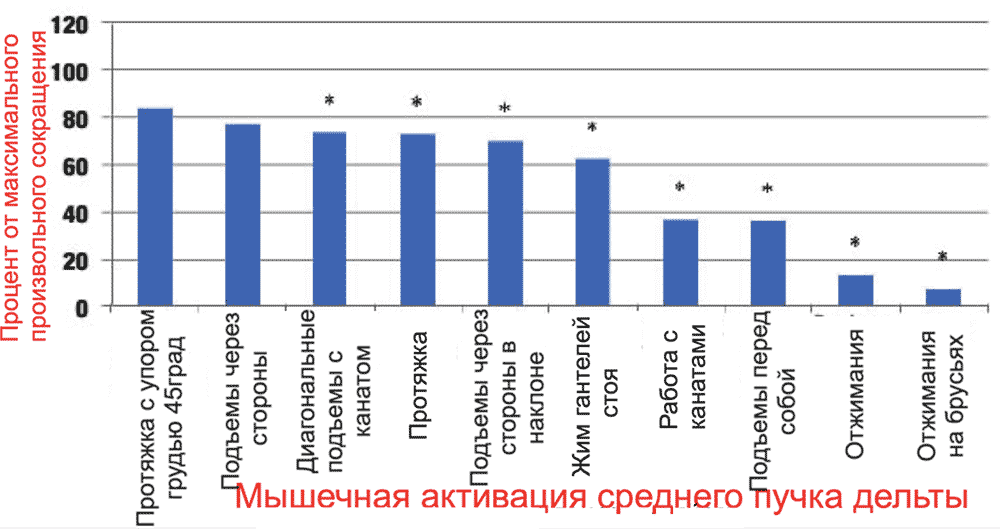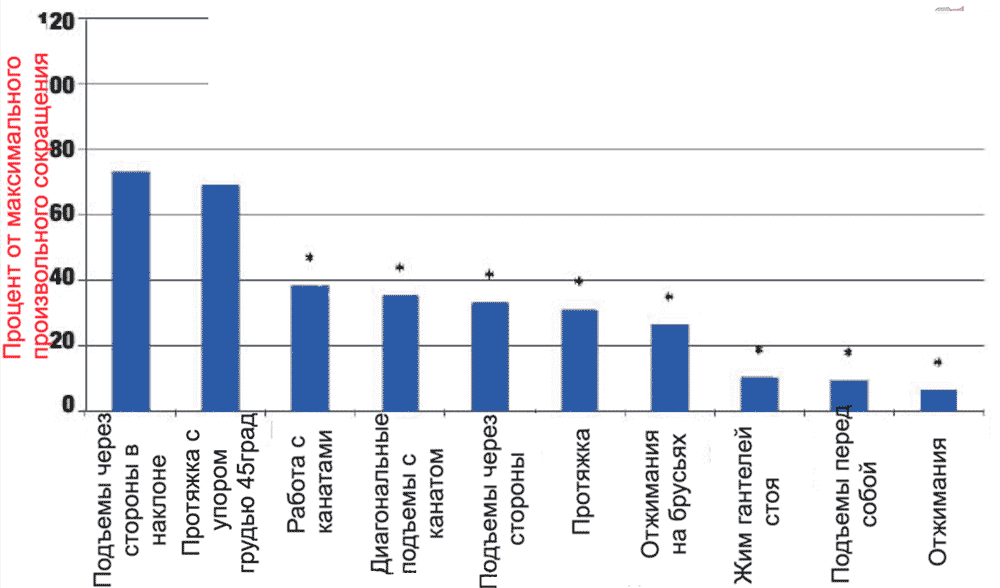Training the deltoid muscles is one of the most challenging tasks for trainers, regardless of the athlete’s level of preparation or the specifics of the sport. The question of deltoid hypertrophy requires a systematic approach, taking into account the anatomy, biomechanics, and anthropometric characteristics of the athlete.
Anatomy and Features of the Shoulder Complex
The shoulder complex is the most complex joint complex in the body.
It includes three physiological joints and one floating joint: the glenohumeral, acromioclavicular, sternoclavicular, and scapulothoracic joints. This structure provides a vast range of movements, including extension, flexion, abduction, and various rotations of the arm.
The large number of degrees of freedom requires careful control of the angle of load application and the trajectory of movement in each exercise.
The goal of training is to standardize the technique so that each repetition is performed identically, excluding random deviations.
Innervation and Segmental Work of the Deltoid Muscle
The deltoid muscle is one of the most richly innervated. The anterior bundle receives signals from three nerves, the middle from one, and the posterior from another three. This means that the angle and direction of load application significantly affect the degree of activation of motor units.
The formal division into three bundles is conditional: myographic studies show that the deltoid has at least seven segments that work as synergists or antagonists depending on the technique.
Individual Technique Execution
The acromioclavicular joint has an individual angle of position for each person, which determines the optimal trajectory of movements.
There is no universal technique, for example, for lateral raises. It is necessary to assess the client’s anthropometry and select the optimal angle of arm movement to exclude excessive work of the anterior bundle and activate the middle one.
Priority Zones for Training
Most athletes, regardless of experience, show a lag in the middle and posterior bundles of the deltoid muscle.
The anterior bundle is loaded in almost all chest exercises and often does not require separate targeted work.
The main focus should be on developing the middle and posterior bundles, which do not receive sufficient load or receive it in an ineffective form.
The Role of Scapular Fixation
Scapular fixation is a key factor. During scapular elevation, the load shifts from the deltoid muscle to the trapezius. Therefore, it is advisable to perform exercises in conditions that minimize scapular mobility: with chest support, lying down, or in machines with body fixation.
Range of Motion
A large range of motion complicates control over the target muscle.
It is optimal to raise the arm no higher than 90 degrees in shoulder abduction when working with light weights.
For experienced athletes and strength work, a limited range of motion (the first 30 degrees) is effective, provided the scapulae remain stable.
Principles of Training Construction
- Shoulders are trained on a separate day or in combination with muscle groups that minimally affect deltoid recovery;
- The anterior bundle is loaded indirectly on chest day; additional work is usually not required;
- The middle and posterior bundles can be worked on chest day or in a separate workout;
- The choice of angles and ranges is made individually for each athlete;
- Rotational movements are performed smoothly and carefully to protect the rotator cuff;
- Priority is given to technique and minimizing injury risk rather than maximum weights.
Periodization and Intensity
For effective development of the deltoid muscles, it is important to alternate periods of strength work and high-volume training.
Example: 3-4 weeks of strength work with heavy weights and long rest between sets, followed by 2-3 weeks of high-volume work with lighter weights and short rest.
Training Frequency and Priority
The optimal frequency for training the deltoid muscles is twice a week, adjusted for individual recovery.
Priority is distributed based on goals:
- Classic bodybuilding — greater emphasis on the posterior bundle for volume and roundness of the deltoids;
- Women’s categories (body fitness) — priority on the middle bundle for silhouette expansion and forming a V-shaped shoulder line;
- The middle bundle is trained more intensely, the posterior with larger volumes, while the anterior primarily receives load during chest workouts.
Exercise Selection and Load Distribution
For enthusiasts, a limited set of exercises for the middle and posterior bundles is sufficient.
For competitive athletes, a variety of movements covering all segments of the muscle and different angles of load is required.
Using a single exercise with constant weight increase is limited by the risk of shoulder joint injury, so movement rotation is necessary.
Anterio Bundle
The best exercises for the anterior bundle of the deltoid are presses (with dumbbells or a barbell), front raises, and shoulder joint extensions, as well as cable work.
 Exercises for the anterior bundle of the deltoid
Exercises for the anterior bundle of the deltoid
At the same time, it is necessary to consider:
- Warm-up is mandatory — joint gymnastics and light rotator cuff work before the strength part;
- Push-ups are beneficial before strength movements for preliminary activation of the anterior bundle;
- In the strength part, the main focus is on presses (seated or standing), after which front raises can be used for a finishing effect;
- During a standard chest workout, the anterior bundle receives sufficient load, so at the end of the workout, only two exercises can be added: press and front raise.
Middle Bundle
The middle bundle of the deltoid is less innervated and activates more slowly, so it requires a larger training volume.
 Exercises for the middle bundle of the deltoid
Exercises for the middle bundle of the deltoid
The most effective exercises are:
- Pulling with chest support at a 45° angle, excluding scapular elevation and cheating;
- Lateral raises while lying on a flat or slightly inclined bench (15-20°);
- Pulling on the lower block of the crossover while lying down, providing constant tension and minimizing trapezius involvement;
- Presses standing or seated, which partially engage the middle bundle but are not a priority exercise for it;
Number of exercises: 3-4, number of sets — 5-8, considering the athlete’s experience and the need for a warm-up before each exercise.
Posterior Bundle
The posterior bundle of the deltoid muscle is anatomically smaller and is poorly involved in everyday activities. For its development, exercises with light weights and controlled technique are recommended, often in machines (for example, in the pec deck), focusing on the quality of contraction and control of amplitude.
 Exercises for the posterior bundle of the deltoid
Exercises for the posterior bundle of the deltoid
Main problems:
- It is difficult to control the amplitude in classic lateral raises in a bent position;
- It is more effective to use machines with body fixation or benches that provide a stable trajectory of movement;
- Alternatives: one-arm Heini pulls in the Smith machine, diagonal raises with cables or the lower block of the crossover;
- Fiber characteristics — the predominance of slow muscle fibers requires working in a larger range of repetitions with weight progression;
Number of exercises: 5-6, number of sets — up to 10, repetition range — high.
Technical Emphasis and Safety
- Individual selection of exercises based on anthropometry and rotation of the acromioclavicular joint;
- Control of the negative phase of movement — the main source of stimulating effect on the muscle;
- Static holds are not a priority for hypertrophy but are useful for strengthening the ligamentous apparatus;
- Working with heavy weights is only permissible with perfect technique and minimized amplitude (especially for the middle bundle in the first 30% of the amplitude);
- All pressing movements are performed considering the flexibility of the shoulder joint, avoiding excessive depth and excessive load on the joint-ligament apparatus;
- Regular stretching, rotator cuff work, and shoulder girdle massage are mandatory for maintaining mobility and preventing injuries.
Conclusion
Training the deltoid muscles requires a comprehensive approach that combines a thoughtful selection of exercises, consideration of individual anatomy, and strict control of technique. Priority is given to the development of the middle and posterior bundles, with work conducted considering amplitude, angles, and shoulder joint safety.
Regular injury prevention and flexible periodization of the training process will ensure sustainable progress and the maintenance of shoulder complex health.



















